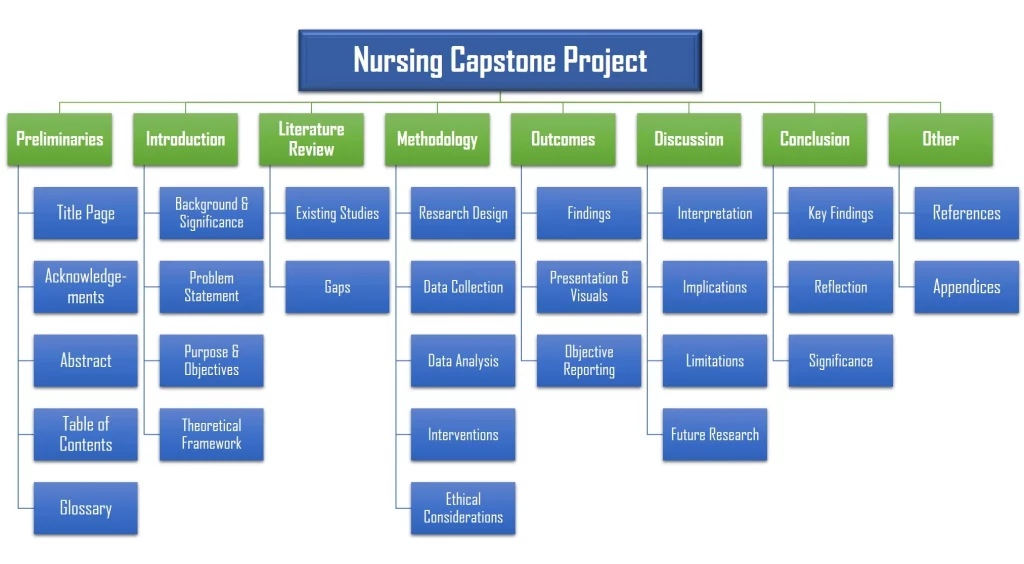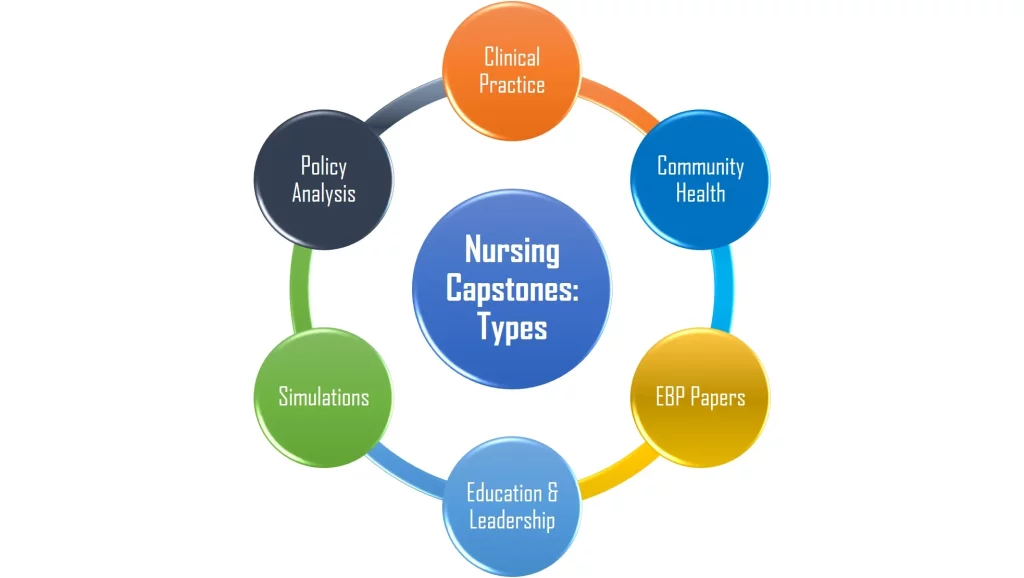
A nursing capstone project is a culminating academic and practical experience designed to integrate and apply the knowledge and skills gained throughout a nursing program. It typically serves as a final requirement for nursing students at the undergraduate or graduate level. The capstone project provides students with the opportunity to demonstrate their proficiency in nursing practice, critical thinking, research, and leadership.
Key Characteristics
- Integration of Knowledge: The project integrates theoretical knowledge from nursing courses with real-world application in a clinical setting.
- Clinical Practice Emphasis: Often, the capstone project involves hands-on experience in a healthcare setting, allowing students to apply nursing interventions, assess patient needs, and implement evidence-based practices.
- Problem Solving: Nursing capstone projects often focus on addressing a specific healthcare issue or problem. Students are expected to identify, analyze, and propose solutions to a healthcare challenge.
- Research Component: Students are usually required to conduct a comprehensive literature review, gather evidence, and apply research findings to support their project. This reinforces the importance of evidence-based practice in nursing.
- Professional Development: The capstone project encourages the development of leadership skills, effective communication, and collaboration with healthcare teams. Students may work on projects that involve policy analysis, quality improvement initiatives, or program development.
- Presentation and Documentation: Nursing students typically present their capstone projects through written reports, presentations, or posters. This documentation serves as a record of their work and a means of sharing their findings with the academic community.
Overall, the nursing capstone project is a comprehensive and hands-on experience that prepares students for the challenges of nursing practice by combining theoretical knowledge with practical application in a real-world healthcare environment.
Nursing Capstone Project Format
- Title Page: Includes the title of the capstone project, the student’s name, the name of the educational institution, and the date of submission.
- Abstract: Provides a concise summary of the capstone project, including the problem addressed, objectives, methods, results, and conclusions. It gives readers a quick overview of the project’s key aspects.
- Acknowledgments: Optional section where the student expresses gratitude to individuals or organizations that contributed to the project.
- Table of Contents: Outlines the main sections and subsections of the capstone project with corresponding page numbers for easy navigation.
- List of Tables and Figures: If applicable, includes a list of tables and figures along with their titles and page numbers.
- Introduction:
- Literature Review:
- Methodology:
- Results/Outcomes:
- Discussion:
- Conclusion:
- Recommendations:
- References: Lists all sources cited in the capstone project following a specific citation style (e.g., APA, MLA).
- Appendices: Includes additional materials such as survey instruments, interview guides, consent forms, or any supplementary information that supports the project.
It’s important to adhere to any specific formatting guidelines provided by the educational institution or program. Additionally, students should carefully follow the citation style specified for their capstone project.
Types of Nursing Capstone Projects

Nursing capstone projects can take various forms, depending on the program, academic level, and specific goals of the project. Here are common types of nursing capstone projects:
- Clinical Practice Improvement Project:
- Community Health Project:
- Research Study (Evidence-Based Practice Capstone Paper):
- Quality Improvement Initiative:
- Policy Analysis and Development:
- Leadership Project:
- Simulation-Based Project:
- Educational Program Development:
- Global Health Project:
- Telehealth Initiative:
These examples illustrate the diversity of nursing capstone projects, reflecting the broad scope of the nursing profession and the multifaceted nature of healthcare. The specific type of capstone project can vary based on the educational institution, program requirements, and the interests and goals of the nursing students involved.
Nursing Capstone Project Ideas & Examples
BSN (Bachelor of Science in Nursing) Capstone Project Ideas:
- Improving Patient Education on Chronic Conditions: Develop and implement an educational program for patients with chronic conditions to enhance self-management skills and reduce hospital readmissions.
- Reducing Hospital-Acquired Infections: Design a quality improvement initiative to decrease the incidence of hospital-acquired infections by implementing evidence-based infection control measures.
- Enhancing Communication in Multidisciplinary Teams: Create a communication training program for healthcare teams to improve collaboration and communication in a hospital setting.
- Addressing Mental Health Stigma: Develop a community-based mental health awareness campaign to reduce stigma and promote early intervention for mental health issues.
- Promoting Healthy Lifestyles in Schools: Implement a health promotion program in schools to encourage healthy eating habits, physical activity, and overall wellness among students.
- Implementing a Fall Prevention Program: Develop and implement a fall prevention program in a healthcare facility, incorporating risk assessments and personalized interventions.
- Improving Medication Adherence in Elderly Patients: Design an intervention to improve medication adherence among elderly patients with multiple chronic conditions, considering factors like polypharmacy.
- Culturally Competent Care Training: Develop a training program to enhance cultural competence among nursing staff, addressing the unique healthcare needs of diverse patient populations.
- Telehealth Integration in Home Healthcare: Explore the implementation of telehealth technologies in home healthcare settings to improve patient monitoring and access to healthcare services.
- Enhancing End-of-Life Care: Develop a program to improve end-of-life care by addressing communication, symptom management, and support for patients and their families.
MSN (Master of Science in Nursing) Capstone Project Ideas:
- Implementing a Nurse-Led Clinic: Establish and evaluate the effectiveness of a nurse-led clinic to address specific community health needs, such as primary care for underserved populations.
- Developing a Nurse Residency Program: Create a comprehensive nurse residency program to support new graduate nurses in their transition to professional practice and reduce turnover rates.
- Advanced Practice Nurse-led Diabetes Management: Design an advanced practice nurse-led program for the management of diabetes, focusing on patient education, monitoring, and personalized care plans.
- Evaluating the Impact of Nursing Informatics: Conduct a research study to assess the impact of nursing informatics on patient outcomes, workflow efficiency, and nursing practice.
- Integrating Palliative Care in Chronic Illness Management: Develop a model for integrating palliative care principles into the management of chronic illnesses, emphasizing patient and family-centered care.
- Exploring the Effectiveness of Mindfulness Interventions: Conduct a research study on the effectiveness of mindfulness interventions in reducing stress and burnout among nursing professionals.
- Implementing a Patient Navigation Program: Design and implement a patient navigation program to improve continuity of care and access to healthcare services for vulnerable populations.
- Leadership Development for Nurse Managers: Develop a leadership development program for nurse managers to enhance their leadership skills, conflict resolution, and team management.
- Enhancing Patient Safety Culture: Design and implement strategies to enhance the patient safety culture within a healthcare organization, focusing on communication, reporting, and continuous improvement.
- Integrating Genetics and Genomics Education: Develop an educational program for nursing staff to enhance their understanding of genetics and genomics, emphasizing its implications for patient care.
DNP (Doctor of Nursing Practice) Capstone Project Ideas:
- Implementing a Telepsychiatry Program: Establish and evaluate the effectiveness of a telepsychiatry program to increase access to mental health services, especially in rural or underserved areas.
- Developing a Transitional Care Model: Design and implement a transitional care model to improve the continuity of care for patients transitioning from hospital to home, with a focus on chronic conditions.
- Advanced Practice Nurse-led Quality Improvement: Lead a quality improvement initiative within a healthcare organization, utilizing advanced practice nursing skills to enhance patient outcomes.
- Implementing a Nurse Practitioner Residency: Establish and evaluate the outcomes of a nurse practitioner residency program to support the transition of new NPs into advanced practice roles.
- Integrating Genomic Medicine into Primary Care: Develop and implement a program to integrate genomic medicine into primary care settings, focusing on personalized treatment plans based on genetic information.
- Evaluating the Impact of Nurse-led Clinics on Access to Care: Conduct a comprehensive evaluation of nurse-led clinics to assess their impact on patient access to care, health outcomes, and cost-effectiveness.
- Implementing an Advanced Care Planning Program: Develop and implement an advanced care planning program to facilitate meaningful discussions about end-of-life preferences among patients and their families.
- Leadership in Healthcare Policy Advocacy: Advocate for healthcare policy changes by developing and implementing a strategic plan to address a specific healthcare issue or disparity.
- Integrating Behavioral Health in Primary Care: Design and implement an integrated behavioral health program within primary care settings to improve access to mental health services and enhance patient outcomes.
- Developing a Population Health Management Strategy: Develop a comprehensive population health management strategy, incorporating data analytics, care coordination, and community partnerships to improve health outcomes for a specific population.
These capstone project ideas are designed to align with the academic level of the nursing program and provide opportunities for students to apply advanced nursing knowledge and skills in addressing real-world healthcare challenges.
In conclusion, the key key to success in a nursing capstone project is a thorough understanding of healthcare concepts, effective application of evidence-based practices, clear communication, and a focus on improving patient outcomes. Success is achieved by addressing real healthcare challenges, proposing practical solutions, and demonstrating clinical and research competencies.
